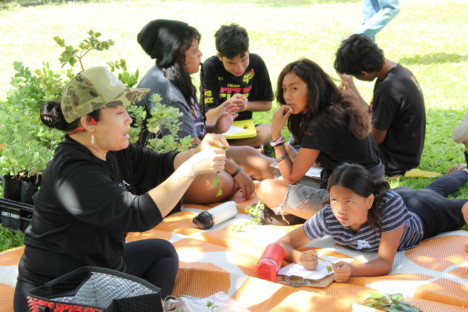Ho‘aka Mana’s Program Strengthens Laka Connection
By Léo Azambuja
More than a dozen children spent two days at Molokai Public Library last week, planting several Native Hawaiian plant species around the property. But the purpose wasn’t to beautify the 88-year-old historic building; it was part of Ola O Laka, a program to strengthen Native Hawaiian identity.
“It’s a program that we created to honor Laka. Laka is the native forest. As Native Hawaiians, we are just trying to revitalize it, bring more education around it, but specifically the connection to Laka,” Ho‘aka Mana executive director Kanoe Davis said. “She is all things hula, and she is all things forest.”
Ola O Laka is the nonprofit organization Ho‘aka Mana’s community-based program to revitalize traditional Native Hawaiian relationships with native plants, forests and healing practices, according to Davis. For two weeks, the program took children and community members to specific places on the island, teaching them about Laka.
“Ola O Laka is really about how do we identify ourselves with the forest, how do we identify ourselves with plants,” she said. “When we can understand how the plants are thriving, we can understand how we can thrive, and then how that partnership and collaboration and connectivity is viable for the culture, for our people.”
Rooted in ʻike kūpuna while bridging modern mindsets, the program aimed at strengthening hands-on learning, cultural protocol and environmental stewardship, Davis said.
The activities included forest plant identification that relate to Laka, a journey through time with history of hula and how the forest plays an integral role to the practitioner, filled with dirty fingernails, art and creativity and oli.
During the first week, the program took community members to Kamakou Preserve, where they learned how to identify plants, Davis said. They brought back some plants to share with the community what Laka looks like.
The 2,774‐acre preserve was established in 1982 to protect the habitat of endemic forest birds. It is home to 44 rare plant taxa, 23 of which are listed endangered, according to the state Department of Land and Natural Resources.
Some of these people, Davis said, had never been to Kamakou, and had never seen or even heard of some of the forest plants in the preserve.
“They also learned that Laka is something more than just hula,” Davis said, adding they learned Laka is also the forest, their own environment.
Additionally, Ola O Laka took some kids to Molokai Land Trust’s nursery in Kualapu‘u to show them a native plant nursery and do more plant identification.
Participants also made art, creating Hawaiian prints with olena and other dyes.
During the program’s second week, 15 kids went to Molokai Public Library and, under the mentorship of Ho‘aka Mana staff, learned how to properly identify the plants, their cultural significance, their natural habitats and their practical uses.
And then they went to work.
“Who wants to get dirty?” Davis asked the children.
It didn’t take much convincing. Most of them seemed at ease with handling soil and manure. They planted the plants in four different locations around the library.
The plants came from the community, from Molokai Land Trust’s nursery, from Kamakou and from Haloa O Honouliwai lo‘i.
Davis said besides Ola O Laka, Hoaka Mana has multiple programs, and their main focus is strengthening indigenous identity.
“Ola O Laka uplifts the role of cultural practitioners as stewards, teachers and healers while reconnecting ʻohana to the ʻaina for wellness and self-sovereignty. By integrating land-based healing with education and community action, the program fosters thriving ecosystems, both ecological and cultural,” she said.
Ola O Laka closed July 13 at Haloa O Honouliwai on the East End, where community members learned how to ku‘i, or pound, kalo and opened a new lo‘i.
Visit www.hoakamana.org for more information.












Don't have a Molokai Dispatch ID?
Sign up is easy. Sign up now
You must login to post a comment.
Lost Password